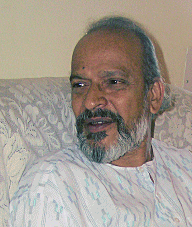In My View:
preserving Aprachalit Raga-s

In My View:preserving Aprachalit Raga-s
|

|
By Pandit Rajshekhar Mansur |
Pandit Rajshekhar Mansur is the finest example of Alladiya school of singing. The complex-patterns of Jaipur-Atrauli gharana were woven into his singing by Ustad Alladiya Khan (1855-1946) actually named Ghulam Ahmad Khan. Rajshekhar ji's father Pt. Mallikarjun Mansur learnt with Pt. Neelkanthbua Alurmath of Gwalior Gharana and Ustad Manji Khan and Ustad Burji Khan, sons of Ustad Alladiya Khan. After retiring from Karnatak university as professor in English, Pr. Rajshekhar Mansur is looking after Sangeetha Nrithya Academy as its President. |
 |
I have been fortunate in learning from my father. The man they called 'the doyen of Jaipur-Atrauli Gharana', the last of the purists', and more, Pt. Mallikarjun Mansur appeared to be born only to sing which he did from the tender age of 10 to the last days of his life at the age of 82. Hailing from Mansur, a hamlet near Dharwad, he trained in two of the leading gharanas -- Gwalior and Jaipur-Atrauli. Panditji's Gayaki was unique in that he successfully amalgamated the two gharanas and evolved a personal identity of his own. I have inherited such a treasure of music that I do not need to create a Raga of my own. If I am able to sing all I have learnt that would be sufficient.
Any and every Raga sung in its true spirit is complex; there is nothing called simple. Even Prachalit Raga can be complex because of the structure the musician is trying to weave.
In the case of so-called Aprachalit (rare, not commonly practiced) Raga-s, since two or three Raga-s are blended and not mixed -- as people sometimes call it -- they are so beautifully blended that a third Raga seems to be born out of this blending. There is a total surrendering of these two Raga-s out of which a third Raga comes out. if you know the other prakaar-s (types, variants) of a raga it will help you in understanding the mood of that particular Raga. For example, knowing Alhaiya Bilawal, Yamini Bilawal, Kukubh, Shukla Bilawal etc. gives you a much through understanding of Bilawal. What our ancestors have done is to explore the possibilities of a Raga in terms of knowing the prakaar-s of raga.
The reason why musicians don't sing these aprachalit raga-s is that they have not been taught these raga-s. The problem is that Guru-s should recognize that there has been a huge huge treasure of Raga-s available traditionally, which they don't know! Many people make do with twenty, twenty-five, thirty Raga-s. A true Guru is one who has gone into the depths of this heritage and tried to know what the number of raga-s there existed. So from out of this treasure we can find so many gems.
The listeners are little to blame as they have never been exposed to these raga-s. Take a so-called common raga, like Puriya. Everybody sings; the audience goes on listening to Puriya and soon getting familiar they get so attuned to it that they can not appreciate an aprachalit raga. Thus, it is not their shortcoming. An aprachalit raga must also be given to the audience so that gradually they begin to understand the aprachalit raga. The first time they hear maybe they don't, the second a little bit, more on third, fourth time and so on. If you go on feeding the audience with aprachalit Raga-s gradually they will become familiar with these aprachalit raga-s. Personally, I tend to give at least two rare raga-s in my performances. In fact, may people have been complaining I don't sing common raga-s. It's not that. I have sung common Raga-s also. But I feel it's my duty to raise, to lift the standards of the audience -- not to sing to the tastes of audience alone but to create a new awareness amongst them.
My desire is that more and more people should listen to these raga-s which have not so often been performed. Creation is only possible when you have exhausted that available in present. With so much to preserve, I can not justifiably create a new Raga.

Links:
In My View: Ustad Vilayat Khan
In My View: Dr. Chandrakant Sardeshmukh
In My View: Dr. Sanjoy Bandopadhyaya